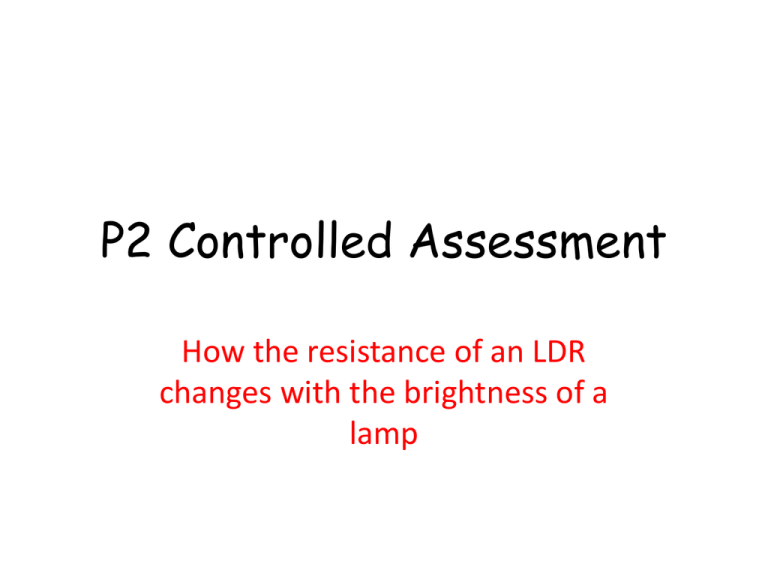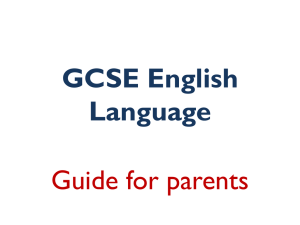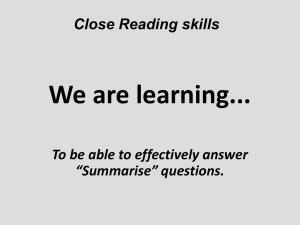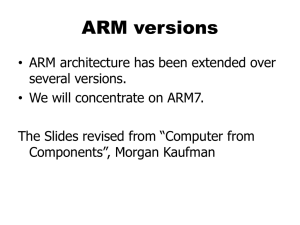File - singhscience
advertisement

P2 Controlled Assessment How the resistance of an LDR changes with the brightness of a lamp The controlled assessment is internally assessed and forms 25% of each GCSE in science. Controlled Assessments (CAs) Controlled assessments are been split into three parts: Part A Part B Part C Planning Observations Conclusion (limited control) (limited control) (high control) You will need to complete all three. E.g. The plan in part A is used to collect the results for part B and for the conclusion in part C. Part A Planning (limited control) For GCSE Science you will be given an hypothesis (a scientific idea to be investigated). You will then have to carefully plan how you will test the idea. 20 marks Rules: You are allowed to work groups/ teams to discuss ideas etc When planning you can have access to your class notes. You may be allowed more than one lesson to finish your plan. However you must write up your plan individually in class under teacher supervision.. When finished your teacher will check your plan. Your plan cannot be changed once it has been checked. If your plan is deemed as dangerous, your teacher will give you a suggested plan, but no marks can be awarded. Rules: Limited control. You can work in groups/teams during experimental work to discuss ideas and to generate results. However you must write up and record your own data/ evidence. You will also need to collect and record secondary evidence to support the hypothesis and comment on the quality of the source. (Best to use another groups/students results plus your own internet research) 24 Marks Rules: High control – this must be completed individually under the supervision of your teacher. This can take place over several lessons but your work must be collected in at the end of each lesson. Can collect evidence for homework. Must be your own work. Absent pupils, will be given results – no marks awarded for data. P2 Year 11 Controlled Assessment To put it simply! • Your are going to change the voltage, this will increase the current and make the bulb brighter. • You will then see how this effects the resistance of the LDR. Current is a measure of the rate of flow of electric charge through a circuit. A large current means that the rate of flow is more rapid. Current can be changed by increasing or decreasing the voltage of the circuit. Resistance is a measure of how hard it is for electrons to move in an electrical circuit. The higher the resistance the harder it is for the current to flow. • Current is measured using in Amps using an ammeter. • Voltage is measured in Volts using a Voltmeter. • Resistance is measured in Ohms using an Ohmmeter. Light Dependent Resistor How it works Light Dependent Resistor • The most common type of LDR has a resistance that falls with an increase in the light intensity falling upon the device (as shown in the graph). The resistance of an LDR may typically have the following resistances: • Daylight= 5000 ohms • Dark= 20000000 ohms What’s the point in LDR’s • To put it simply they are just automatic on/off switches. One every day us of them is in street lighting. During the day the resistance is low so the current has too paths. What’s the point in LDR’s • During the night the resistance of the LDR is very light so all the current will flow through the bulb. Hypothesis 4 Marks • How will the brightness of the light effect the resistance of the LDR? • Key things to remember• The current is a measure of brightness. • This will then effect the resistance of the LDR. Equipment (2 Marks) • What equipment do you think you are going to need? This should be a list with explanations for why you need each thing. Below are some examples. Resistance is measured in Ohms using an Ohmmeter. Current is measured using in Amps using an ammeter. Light dependent resistor will detect light and vary in resistance. A thermistor will detect temperature and vary in resistance. Voltage is measured in Volts using a Voltmeter. Controls • In any scientific experiment we have 3 things: • Independent variable- The thing we change • Dependent variable- The thing we measure • Controls- The things we keep the same. What are our independent and dependent variables? Controls • The things we keep the same to ensure valid results. Ideas for Controls Controls 6 Marks! • To get the full marks in this section you must identify the control, how you will control it and explain why it needs to be controlled. 20 Min’s Risks 4 Marks 10 Min’s • Should be in a list! • Identify the risk, describe what the risk could do to you and explain how you will manage this risk. Writing a Plan Add flour, eggs and backing powder to a bowl. Mix this up and put in a baking tray. Once this is baked add your icing sugar and then leave to set. Could Ernie the Elf make the cake for Lenny the lepricorn with this recipe? What’s Wrong with it? • All in one big paragraph. • Does not mention how long to do anything e.g. bake the cake. • Does not mention the amounts required of each thing. • Just like a recipe your plan needs to be ordered and in detail! • Assume the person reading it knows nothing about the experiment. • Remember as a scientists your plan should be good enough so that anyone could follow it and conduct your experiment. Writing your Plan Hints and Tips 20 Min’s • Write it as a numbered list. • You can draw a labelled diagram of your apparatus. • Explanation for how your plan will test your hypothesis. • Justify your use of a particular range of voltages on the powerpack. Primary Evidence 4 Marks • This section just involves recording your data in an appropriate table • This table should include all your results, including your repeats. • The table must have appropriate headings and units. Surface Force (N) Reading 1 Force (N) Reading 2 Average (cm) Spot the mistakes in this table Secondary Evidence • This is an extra piece of information which can be used to help back up your results. • REMEMBER YOU MUST DESCRIBE WHERE THE PIECE OF SECONDARY INFORMATION IS FROM AND ITS CREDIBAILITY. Credability- Whether the information can be trusted (if you have taken it from wikipedia then it cannot!) and how well it relates to your work (if its the same experiment then its perfect!). Processing Evidence (4 marks) • One you have collected your information you now need to process it. • All this means is you need to need calculate your averages and plot an appropriate graph. Important point- Before you can do any this you need to check you results for anomalies, because you will need to discount these when calculating averages. Quality of Evidence 4 Marks • In this section you need to discuss the quality of all your evidence. • What makes a piece of scientific evidence good quality? Quality of Evidence 4 Marks • Anomalies- have they been dealt with? How? Why? In both primary and Secondary Evidence Important point- if there are no anomalies you need to state THERE ARE NO ANOMOLIES IN MY PRIMARY/SECONDARY EVIDENCE Conclusion Based on Evidence 6 Marks • We have successfully completed a scientific investigation! • Have we proved or disapproved out hypothesis. Conclusion Based on Evidence 6 Marks Height of bounce (m) 2.0 1.5 1.0 0 .5 • Lets use an example to help us to do this! x x x 0 1 2 3 Height of ball off ground (m) My hypothesis is ‘The higher the ball is released the higher the ball will bounce’ Explain if this hypothesis is correct, using evidence to back up your ideas. What's expected from you • Draw conclusions in reference to your hypothesis, did it work out how you expected? • You need to use all your results (table and graph) to back up your conclusions, both your primary and secondary! • e.g. The ball bounced higher when it was released at an increased height. My results show that when it was released at 1m it bounced 10 cm compared to when it was released at 1.5m where it bounced 25cm....... etc • Explain your conclusion using scientific knowledge. If there was a pattern, explain why you think there was, if there was no pattern, explain why there was no pattern. • e.g. The ball bounced higher when it was released at an increased height because the it had more gravitational potential energy..... etc Conclusion Based Evidence Structure Opening Sentence describing if your results had proved or disproved your hypothesis. Back up your opening sentence with various pieces of evidence from your secondary and primary evidence. Explain your conclusion using scientific knowledge. Evaluation of Conclusion 4 Marks • You are now making judgements on the quality of your conclusion and suggesting methods by which you could extend it to support it further. • e.g. Both my primary and secondary data show similar results, to improve my experiment I could have released the ball at more heights, this would helped me further prove whether the height it was dropped affected how high it bounced.. Evaluation of Conclusion 4 Marks Do both the primary and secondary evidence give the same conclusion? Explain how your evidence can be improved and extended to better support your conclusion. Evaluation of Method 6 Marks • Now we are making judgements about the quality of our method, it was good, but was it perfect? • Explain various strengths of weaknesses of your method. These should be linked to your hypothesis. • Make and justify various suggestions to improve your method and explain why this would result in stronger quality of evidence and therefore better prove or disapprove your hypothesis. Evaluation of Method 6 Marks Describe various strengths of your method, you need to link these to your hypothesis. Why did these things ensure you could test your hypothesis. Describe the various weaknesses of your method. You could use these to explain your anomalous results. Suggest and justify improvements to your method. These could be linked to your weaknesses. Explain how these improvements could have better tested your hypothesis.










